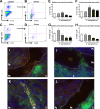Characterization of a novel murine model of Staphylococcus saprophyticus urinary tract infection reveals roles for Ssp and SdrI in virulence
- PMID: 20176795
- PMCID: PMC2863549
- DOI: 10.1128/IAI.01235-09
Characterization of a novel murine model of Staphylococcus saprophyticus urinary tract infection reveals roles for Ssp and SdrI in virulence
Abstract
Staphylococcus saprophyticus, an obligate human pathogen, is the most common Gram-positive causative agent of urinary tract infection (UTI) in young, healthy women. Despite the clinical importance of S. saprophyticus, little is known about how it causes disease in the urinary tract or how the host responds to the infection. Here we established an in vivo model to study both host and bacterial factors contributing to S. saprophyticus UTI. Using this model, we show that S. saprophyticus preferentially infects C3H/HeN murine kidneys instead of the bladder, a trait observed for multiple clinical isolates. Bacterial persistence in the kidneys was observed in C3H/HeN mice but not in C57BL/6 mice, indicating that host factors strongly contribute to the ability of S. saprophyticus to cause UTI. Using C3H/HeN mice as a model, histologic and immunofluorescence analyses of infected tissues revealed that S. saprophyticus induced epithelial cell shedding in the bladder and an inflammatory response characterized by macrophage and neutrophil infiltration in the bladder and kidneys. The inflammatory response correlated with increased production of proinflammatory cytokines and chemokines in both the bladder and the kidneys. Finally, we observed that the putative S. saprophyticus virulence factors Ssp and SdrI were important for persistence, but not for initial colonization, in the murine urinary tract. Thus, we characterized both host and bacterial factors involved in progression of S. saprophyticus UTI, and we describe a useful model system for studying factors involved in the pathogenesis of this Gram-positive uropathogen.
Figures







Similar articles
-
Occurrence of virulence-associated genes among Staphylococcus saprophyticus isolated from different sources.Microb Pathog. 2018 Jun;119:9-11. doi: 10.1016/j.micpath.2018.03.054. Epub 2018 Mar 28. Microb Pathog. 2018. PMID: 29604423
-
The infectious capacity of Enterococcus faecalis, Staphylococcus aureus, and Staphylococcus saprophyticus in a porcine model of urinary tract infection.APMIS. 2024 Nov;132(11):807-813. doi: 10.1111/apm.13469. Epub 2024 Sep 18. APMIS. 2024. PMID: 39295304
-
Effects of subinhibitory concentrations of ciprofloxacin on Staphylococcus saprophyticus adherence and virulence in urinary tract infections.J Endourol. 2012 Jan;26(1):32-7. doi: 10.1089/end.2011.0183. Epub 2011 Sep 9. J Endourol. 2012. PMID: 21905846
-
Staphylococcus saprophyticus as a common cause of urinary tract infections.Rev Infect Dis. 1984 May-Jun;6(3):328-37. doi: 10.1093/clinids/6.3.328. Rev Infect Dis. 1984. PMID: 6377440 Review.
-
Who are you--Staphylococcus saprophyticus?Clin Infect Dis. 2005 Mar 15;40(6):896-8. doi: 10.1086/428353. Epub 2005 Feb 16. Clin Infect Dis. 2005. PMID: 15736028 Review.
Cited by
-
Detection of virulence genes among Staphylococcus saprophyticus isolated from women with urinary tract infections: first report from Iran.BMC Res Notes. 2023 Sep 11;16(1):206. doi: 10.1186/s13104-023-06481-1. BMC Res Notes. 2023. PMID: 37697340 Free PMC article.
-
Gram-Positive Uropathogens, Polymicrobial Urinary Tract Infection, and the Emerging Microbiota of the Urinary Tract.Microbiol Spectr. 2016 Apr;4(2):10.1128/microbiolspec.UTI-0012-2012. doi: 10.1128/microbiolspec.UTI-0012-2012. Microbiol Spectr. 2016. PMID: 27227294 Free PMC article. Review.
-
The immune responses to different Uropathogens call individual interventions for bladder infection.Front Immunol. 2022 Aug 23;13:953354. doi: 10.3389/fimmu.2022.953354. eCollection 2022. Front Immunol. 2022. PMID: 36081496 Free PMC article. Review.
-
Staphylococcus saprophyticus surface-associated protein (Ssp) is associated with lifespan reduction in Caenorhabditis elegans.Virulence. 2013 Oct 1;4(7):604-11. doi: 10.4161/viru.25875. Epub 2013 Aug 6. Virulence. 2013. PMID: 23959029 Free PMC article.
-
A mouse model displays host and bacterial strain differences in Aerococcus urinae urinary tract infection.Biol Open. 2021 Aug 15;10(8):bio058931. doi: 10.1242/bio.058931. Epub 2021 Aug 13. Biol Open. 2021. PMID: 34387311 Free PMC article.
References
-
- Austyn, J. M., and S. Gordon. 1981. F4/80, a monoclonal antibody directed specifically against the mouse macrophage. Eur. J. Immunol. 11:805-815. - PubMed
-
- Daley, J. M., A. A. Thomay, M. D. Connolly, J. S. Reichner, and J. E. Albina. 2008. Use of Ly6G-specific monoclonal antibody to deplete neutrophils in mice. J. Leukoc. Biol. 83:64-70. - PubMed
-
- Fisher, K., and C. Phillips. 2009. The ecology, epidemiology and virulence of Enterococcus. Microbiology 155:1749-1757. - PubMed
-
- Gatermann, S. 1986. Virulence factors of Staphylococcus saprophyticus, Staphylococcus epidermidis, and enterococci, p. 313-340. In H. Mobley and J. Warren (ed.), Urinary tract infections: molecular pathogenesis and clinical management. ASM Press, Washington, DC.
Publication types
MeSH terms
Substances
Grants and funding
LinkOut - more resources
Full Text Sources
Medical

